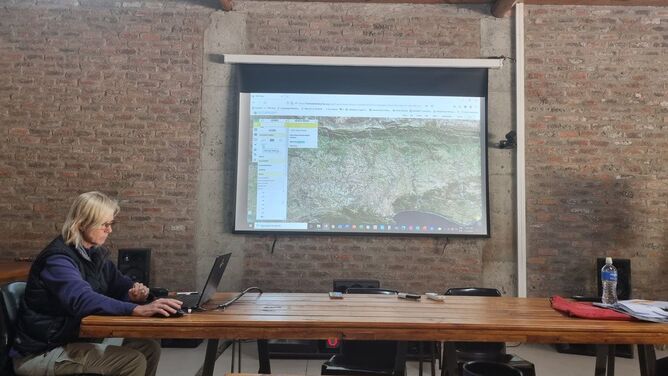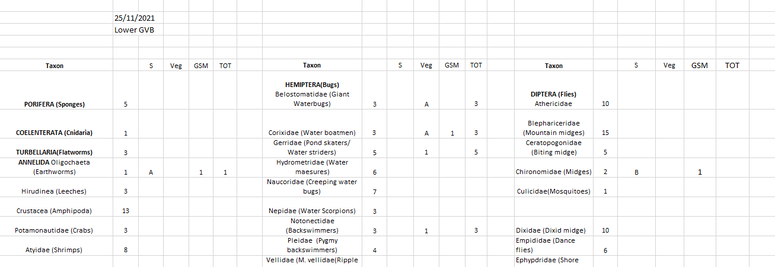|
Before the SASS training We gave ourselves nicknames like Piet-my-vrou, FreshwaterFreak, and Porifera when we first started studying for our SASS training. We used the Kahoot! educational game app (which requires nicknames for the games) to study for SASS as we got pumped up, supported one another, and committed to the upcoming training. We tried for a long time to do this training, and now we're here. We were ecstatic because, if we worked hard, we would be accredited and able to conduct SASS on a regular basis and record the results. Thank you to the Table Mountain Fund for funding this training. SASS (South African Scoring System) is a quick bio evaluation technique. It is based on a single component, benthic macroinvertebrates. Each taxon is assigned a tolerance or sensitivity score, which is then added together to provide a total score. Dickens and Graham SASS is performed to determine the health of the river (Dickens and Graham, 2002). Dickens and Grahams (2002) explains that Bentic macroinvertebrates are what we use for the assessment because they are visible to the naked eye and thus easier to identify. SASS is an appropriate tool for assessing the ecological state of our aquatic ecosystems. To assess emerging problems and set goals for emerging problems. To predict changes within the ecosystem, it is necessary to assess the effects of developments and contribute to the establishment of the ecological reserve. SASS must be performed in low/moderate flow conditions and not in flood conditions. It is also not possible in wetlands or other lentic habitats. The method works best with high biotope diversity, including riffles or rapids. These are some of the protocols from the paper that we needed to be familiar with throughout the training. The freshwater gurus The SASS 5 assessment is included in our GASPP (Grootvadersbosch Species Protection Program) project. During GASPP we are assisted by two freshwater ecologists from Cape Nature one is a fish expert and the other a SASS guru. Jeanne Gouws is the SASS master and the person who usually assists us with SASS but she is busy all over the Western Cape, so we wanted to have people in our organization that are accredited to do this work. The team had previously assisted with SASS under the supervision of Jeanne Gouws (Freshwater ecologist), so we had a few basic theories but now we had to become the gurus. Helen Dallas, who works under the Freshwater Research Center, provided the SASS training. Helen Dallas (Executive Director and Researcher) has over 30 years of experience in Southern African research projects for aquatic ecosystem ecology, conservation, and management. Helen played a key role in the development of aquatic biomonitoring protocols and databases in South Africa, Zimbabwe, Botswana, Swaziland, Tanzania, and Zambia. The training was a combination of theory (lectures) that provided us with a foundation, as well as fieldwork. We practiced sampling methods and protocols, as well as identifications, in the field. The theory was founded on Dickens and Graham's (2002) paper, which we had to be very familiar with. For the sampling, we needed to be completely familiar with the SASS 5 protocol. And we'd need to be able to conduct a full SASS assessment in the river. What we were up to for the 2 days. Helen did the welcome and introductions in the morning on November 23rd, followed by a biomonitoring introduction. We then moved on to SASS VERSION 5, where Helen provided an overview of the sampling method (the practical application). We then moved on to the introduction of aquatic invertebrates, after which we went out to the field to do some sampling. We also had the opportunity to do field sampling on November 24th, and we did individual SASS sampling and practiced field identifications. We dealt with the SASS scores from the fieldwork. Helen also guided us through the FBIS System (The Freshwater Biodiversity Information system). Sampling During the training, Helen went through the sampling methods steps. As a result, when we arrived at our locations, we had to thoroughly inspect it. You can examine the various biotopes to see if there is enough variety, biodiversity, and biotopes to sample. Stones, vegetation, sand/gravel, and mud (GSM) are the biotopes that must be sampled. Helen would ask us which biotope we wanted to sample first during our one-on-one sampling sessions. One would than start to by sampling the rocky biotope. You will then have time to examine your stones and ensure that they are diverse, and you will be able to sample where there are riffles and rapids, in and out of the current, and where the water is fast or slow. You can then check to see if you have both stones in current (SIC) as well as stones out of current (SOOC) at that location. One must kick stones in current for 2 minutes and if there are large bedrock than sampling may last over 5 minutes. Stones out of current should be kicked for one minute. The sampling of the stones in current and out of should be combined when one is ready to identify. There are two types of vegetation: marginal vegetation and aquatic vegetation. Marginal vegetation is overhanging vegetation, but it is necessary to sample both marginal vegetation in current (MVegIC) and marginal vegetation out of current (MVegOOC). MVegIC is sampled over 2 meters in total, while MVegOOC is sampled over 1 meter. One minute of sand/gravel/mud (GSM) sampling is required. This sample is taken in such a way that it can be taken anywhere there is sand, gravel, or mud. You can sample gravel or sand if there is no mud, and vice versa. Visual observation is also required, which entails taking one minute throughout the sampling process to hand-pick any specimens that may have been overlooked. The SASS VERSION 5 score sheet. The SASS 5 score sheet includes the macroinvertebrate taxon as well as the sensitivity scores. The sheet also includes the relevant date, site code, river name, and site description. The HANNA meter is used to record the temperature, pH, electrical conductivity and dissolved oxygen. On the SASS score sheet, you must also write down the coordinates. Coordinates are important, and it can help you if you do it first when you arrive at a site. You can make a note of your riparian and instream disturbances. The sheet also includes a rating that you must complete, which consists of numbers 0-5 and is for the person sampling to rate each of the biotope’s samples in terms of biodiversity as well as how much of the biotope was on the site to be sampled. Visual observation is also required, which entails taking one minute throughout the sampling process to hand-pick any specimens that may have been overlooked. The identification takes 15 minutes in total. The way in which you estimate the abundances is 1=1 which means that you have found one of that specific species. A = 2-10 species and B=10-100, C= 100-1000 species and D=>1000. FBIS (Freshwater Biodiversity Information System). FBIS is a program that can be used to record SASS DATA. FBIS is a tool that serves as a community platform for the inventory and maintenance of freshwater biodiversity data, with the goal of assisting in the assessment of long-term changes in river biodiversity and ecosystem conditions in South Africa. Accreditation We are currently preparing and practicing for our accreditation. Making certain that we are confident and prepared to provide high-quality data. What stood out for the trainees. This training taught some of the trainees that the higher you go up the mountain, the greater the variety and sensitivity of your macroinvertebrates. Invertebrates that are less sensitive and more tolerant to things like pollution can be found in more impacted areas. The interesting macro-invertebrate species stood out for some of the trainees as well. The macroinvertebrates are small and look the same sometimes but it’s interesting work and fascinating to learn this important skill. We also took with us the incredible fact that there are incredible tools available for conservation planning such as SASS 5, miniSASS (that we can conduct with school learners and community members). This is meaningful data that we will share with the landowners so that they are also aware of what is going on within the rivers. Great work! We are having a wonderful adventure with this work, and we are excited to share our findings in the future.
0 Comments
|
AuthorGVB Conservancy Staff Archives
May 2024
Categories |


 RSS Feed
RSS Feed






